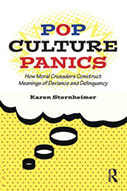Pop Culture Panics: How Moral Crusaders Construct Meanings of Deviance and Delinquency

Author: Karen Sternheimer
Publisher: London, UK; New York: Routledge, 2015. 164p.
Reviewer: Christopher J. Moloney | January 2016
If you teach an undergraduate course on deviance, go ahead and pick up a copy of Karen Sternheimer’s new book, Pop Culture Panics. It is a fantastic resource for students new to sociology and criminology who are grappling with the concept of deviance for the first time.
Sternheimer’s goal in Pop Culture Panics is to provide readers with a “critical lens through which to view” deviance (P. VII). She demonstrates the utility of a social constructionist perspective for understanding how some, but not all, phenomena get defined as deviant and why some deviant conditions or phenomena elicit extreme reactions from society. Readers are shown quite clearly, through the use of interesting case studies, how fear is the underlying motivator behind both our attempts to create new deviant categories and our subsequent overblown reactions to the things we consider deviant.
In Chapter 1, Sternheimer articulates how a social constructionist perspective aligns with the moral panic concept and defines for readers all of the key elements of that concept: moral crusaders, moral entrepreneurs, folk devils, and factors like time and context. Sternheimer then sets the stage for what follows by highlighting how we sometimes define certain conditions or phenomena as deviant because of our fear over how those conditions or phenomena may upset the status quo. Chapter 1 is a great resource for students and instructors, alike given its coverage of key ideas and concepts and would complement classroom lectures on the relativist view of deviance quite nicely.
Chapters 2-5 include various cases that are illustrative of the moral panic concept as it applies to different aspects of popular culture. These cases include the crusade against movies in the early 20th century and that to outlaw pinball machines in the 1930s, as well as the later opposition to comic books and certain kinds of music. In each chapter, Sternheimer is careful to show how the moral panic in question ultimately connects to a time and context specific notion of fear.
Students will no doubt find each of these chapters to be interesting, strange, entertaining and edifying all at once—and will most likely be shocked to learn that things as innocuous as pinball machines and comic books could have scared people as much as they did.
This, inevitably, is one of the key points Sternheimer makes in her work. Moral panics don’t make sense; the things that scare us most don’t actually have to be, and usually are not, all that threatening in reality. Moral panics over comic books or Rock ‘n Roll music are not rational, but rather irrational. This makes sense when we consider how the emotion of fear often leads to all manner of irrational thoughts and actions.
Sternheimer shows then, that what matters in constructing deviance is not reality, but one’s interpretation of it. This interpretation is often provided by some group of people (i.e. those moral crusaders, entrepreneurs, or claims makers) who present a certain phenomenon or thing, like a pinball machine or comic book, as threatening. They then proceed to convince others to accept this definition. Of course, in accepting one definition of some thing’s alleged deviance, we may end up ignoring more valid alternative definitions. This is a serious issue—as Sternheimer sort of points out—since one result of moral panics is the attempted, and sometimes successful, creation of new laws or policies to curb or control the deviant social problem. I think Sternheimer could have hammered this point home a bit more and argued more strongly that ideas about deviance do produce real world consequences.
Sternheimer concludes Pop Culture Panics with a short chapter (Ch. 6) that again makes clear that the fears leading to moral panics are often time and context specific. She hits upon the point again, that we tend to fear things that are new, particularly new technologies, which are regularly blamed for upsetting the established order of our social worlds. A case in point from Sternheimer’s perspective are the new fears over both “new media” and things like “sexting”, though she just as easily could have discussed drones, virtual reality or whatever new technology is currently being received with mixed feelings.
The next time I teach my undergraduate course on the Sociology of Deviance, I will utilize Pop Culture Panics. At just 164 pages and six chapters long, it can easily be assigned as a secondary text for use during the social constructionist section of the course. Alternatively, Pop Culture Panics could easily be the only text you or I need to teach an entire Sociology of Deviance course. It is concise, informative, entertaining and overall, quite good. I encourage you to pick up a copy and see for yourself.


